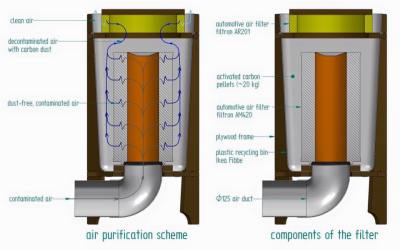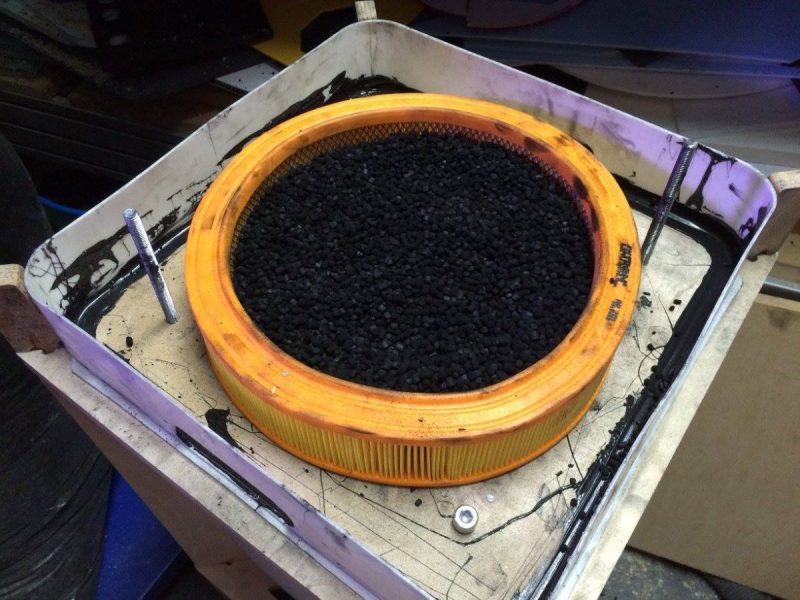A laser cutter is a great tool to have in the shop, but like other CNC machines it can make a lousy neighbor. Vaporizing your stock means you end up breathing stuff you might rather not. If you’re going to be around these fumes all day, you’ll want good fume extraction, and you might just consider a DIY fume and particulate filter to polish the exhausted air.
 While there’s no build log per se, [ZbLab]’s Facebook page has a gallery of photos that show the design and build in enough detail to get the gist. The main element of the filter is 25 kg of activated charcoal to trap the volatile organic compounds in the laser exhaust. The charcoal is packed into an IKEA garbage can around a prefilter made from a canister-style automotive air cleaner – [ZbLab] uses a Filtron filter that crosses to the more commonly available Fram CA3281. Another air cleaner element (Fram CA3333) makes sure no loose charcoal dust is expelled from the filter. The frame is built of birch ply and the plumbing is simple PVC. With a 125mm inlet it looks like this filter can really breathe, and it would easily scale up or down in size according to your needs.
While there’s no build log per se, [ZbLab]’s Facebook page has a gallery of photos that show the design and build in enough detail to get the gist. The main element of the filter is 25 kg of activated charcoal to trap the volatile organic compounds in the laser exhaust. The charcoal is packed into an IKEA garbage can around a prefilter made from a canister-style automotive air cleaner – [ZbLab] uses a Filtron filter that crosses to the more commonly available Fram CA3281. Another air cleaner element (Fram CA3333) makes sure no loose charcoal dust is expelled from the filter. The frame is built of birch ply and the plumbing is simple PVC. With a 125mm inlet it looks like this filter can really breathe, and it would easily scale up or down in size according to your needs.
No laser cutter in your shop to justify this filter, you say? Why not build one? Or, if you do any soldering, this downdraft fume extractor is a good way to clear the air.

















We tried a similar approach at our local Hackspace, however, the cost of replacing the activated charcoal, once saturated, became prohibitive. ($150/3weeks)
how do you “measure” the saturation of the charcoal? Is there a recycling process?
Once the filtered air smells as bad as the unfiltered air, we knew the charcoal was saturated and needed to be replaced.
You can weigh it when you install, and periodically afterwards.
The equilibrium values of water vapor adsorbed by activated charcoal are well-modelled, and the remainder of the difference between the periodic weigh-ins and the initial weigh-in is a measure of how “full” the charcoal is.
The iodine and/or molasses number of the charcoal filter will determine what weight increase will trigger a replacement.
Unless you were going through 55 lbs of granulated activated carbon every three weeks, you were paying too much.
You’d be better off running your air through a cold trap first so that the carbon only had to deal with the most volatile substances.
How cold?
You can reuse activated charcoal by baking it. It will remove any volatile compounds trapped in the pores.
Spreading those compounds throughout your kitchen.
(Kidding—I assume you meant that you’d use an outdoor oven.)
Ok, from what is being described here there is a pre-filter and a carbon filter, but no HEPA filter. From what I understand this will remove most of the odor and visible smoke, but the smallest and most harmful particles will still make it through.
Yup, this thing is close to worthless without a HEPA filter in it. The larger particles are easier to cough out, it’s the super tiny stuff that gets you.
A HEPA filter isn’t going to do much for you either because the particles are atomized by the laser. You’re going to need to step it up to something like ULPA.
I’m pretty sure that’s an air filter from an OM617!!
Probably at least similar. The CA3333 fits quite a few European cars produced from the 1960’s to the 2000’s… lots of VW’s, Audi’s, Citroën, etc. The CA3281 is a pretty common industrial/agricultural air filter.
We use a custom filtration system that first passes the hot exhaust gasses thru a wet, humidifier element which condenses most of the vapors (we cut a lot of Acrylic). The cooled gasses then pass through an activated charcoal layer, which seems to last a long time. This ‘reduced emissions’ exhaust is then piped to the outside world. There is little noticeable odor at the exterior vent.
Could you share more about the humidifier element?
We use Bionaire humidifier media – similar products available at big box home improvement outlets in the HVAC department. The media is a mildew resistant wick that is framed, and suspended vertically in our first filter stage. The bottom of the wick remains in water which creates a damp ‘curtain’ that the exhaust gasses pass thru before reaching the charcoal second stage. We added a seal around the wick which prevents bypassing. Seems to work really well without impeding airflow too much. Wick can be washed if necessary, or easily replaced.
Hi, G3, any chance you can post some pictures of your filtering system and link to used framed Boinaire humidifier wick? Doesn´t passing a humidified air to activated charcoal layer actualy decreases AC life as it absorbs water molecules? Thanks.
Interesting, I’ve not heard of using an evap-cooling medium to condense vapor. What types of particulate filters do you have before the evap? Also, what are the dimensions of the evap?
I like the design and have a similar DIY article on making a filter for laser engravers where the filter is built into the table / stand. Figured you and your readers may find it helpful: https://lookinto.com/home/48885/diy-laser-engraver-filtration-table-home
Thanks to everyone for sharing their local exhaust and dilution ventilation tips!
I recommend that people consider doing air monitoring of the space where work is taking place, as well as at the “breathing zone” (imagine a invisible bubble around a person’s head) of whoever is working in the space. Until you have empirical data showing what the potential contaminant(s) are, and at what concentration, it is hard to say what the best course of action is when designing an effective system to control safety hazards.
Maybe you have an over-engineered (hooray!) or insufficient (nooo!) system, but without the air monitoring, it will be hard to say for sure.
Good luck, be safe!
Or at least my neighbors will breathe more easily, since my laser cutter exhaust vents close to the property line.
The biggest issue I see is that the fan is between the machine and filter. The fumes and soot will destroy the fan motor and bearings. This happened at TechShop and they had to replace the roof exhaust system with one designed for fumes.
Yes, I agree with you on the point that having a laser cutter tool in one’s shop gives it an edge. Honestly, I am getting scared of doing the job myself. In every sector, experiences matter. Hence, I think I am not fit for it. Really I would want to make an appointment with a good expert who will help me to do this job. To avoid any inconvenience in the middle of the job, you should employ a pro or if you are a great experimenter, do this under the direct supervision of the professional.